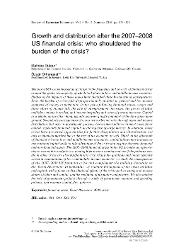| dc.contributor.author | Dufour, Mathieu | |
| dc.contributor.author | Orhangazi, Özgür | |
| dc.date.accessioned | 2019-06-27T08:01:48Z | |
| dc.date.available | 2019-06-27T08:01:48Z | |
| dc.date.issued | 2016 | |
| dc.identifier.issn | 2049-5323 | en_US |
| dc.identifier.issn | 2049-5331 | en_US |
| dc.identifier.uri | https://hdl.handle.net/20.500.12469/473 | |
| dc.identifier.uri | https://doi.org/10.4337/roke.2016.02.02 | |
| dc.description.abstract | The post-1980 era witnessed an increase in the frequency and severity of financial crises around the globe the majority of which took place in low-and middle-income countries. Studies of the impacts of these crises have identified three broad sets of consequences. First the burden of crises falls disproportionately on labor in general and low-income segments of society in particular. In the years following financial crises wages and labor share of income fall the rate of unemployment increases the power of labor and labor unions is eroded and income inequality and rates of poverty increase. Capital as a whole on the other hand usually recovers quickly and most of the time gains more ground. Second the consequences of crises are visible not only through asset and income distribution but also in government policies. Government policies in most cases favor capital especially financial capital at the expense of large masses. In addition many crises have presented opportunities for further deregulation and liberalization not only in financial markets but in the rest of the economy as well. Third in the aftermath of financial crises in low-and middle-income economies capital inflows may increase as international capital seeks to take advantage of the crisis and acquire domestic financial and non-financial assets. The 2007-2008 financial crisis in the US provides an opportunity to extend this analysis to a leading high-income country and see if the patterns visible in other crises are also visible in this case. Using the questions and issues typically raised in examinations of low-and middle-income countries we study the consequences of the 2007-2008 US financial crisis and complement the budding literature on the 'Great Recession.' In particular we examine the impacts of the crisis on labor and capital with a focus on distributional effects of the crisis such as changes in income shares of labor and capital and the evolution of inequality and poverty. We also analyse the role of government policies through a study of government taxation and spending policies and examine capital flow patterns. | en_US] |
| dc.language.iso | eng | en_US |
| dc.publisher | Edward Elgar Publishing Ltd | en_US |
| dc.rights | info:eu-repo/semantics/openAccess | en_US |
| dc.subject | Financial Crisis | en_US |
| dc.subject | Great Recession | en_US |
| dc.subject | 2008 Crisis | en_US |
| dc.title | Growth and Distribution After the 2007-2008 US Financial Crisis: Who Shouldered the Burden of the Crisis? | en_US |
| dc.type | article | en_US |
| dc.identifier.startpage | 151 | en_US |
| dc.identifier.endpage | 174 | |
| dc.relation.journal | Review of Keynesian Economics | en_US |
| dc.identifier.issue | 2 | |
| dc.identifier.volume | 4 | en_US |
| dc.department | Fakülteler, İktisadi, İdari ve Sosyal Bilimler Fakültesi, Ekonomi Bölümü | en_US |
| dc.identifier.wos | WOS:000376170200002 | en_US |
| dc.identifier.doi | 10.4337/roke.2016.02.02 | en_US |
| dc.identifier.scopus | 2-s2.0-84963677674 | en_US |
| dc.institutionauthor | Orhangazi, Özgür | en_US |
| dc.relation.publicationcategory | Makale - Uluslararası Hakemli Dergi - Kurum Öğretim Elemanı | en_US |
















